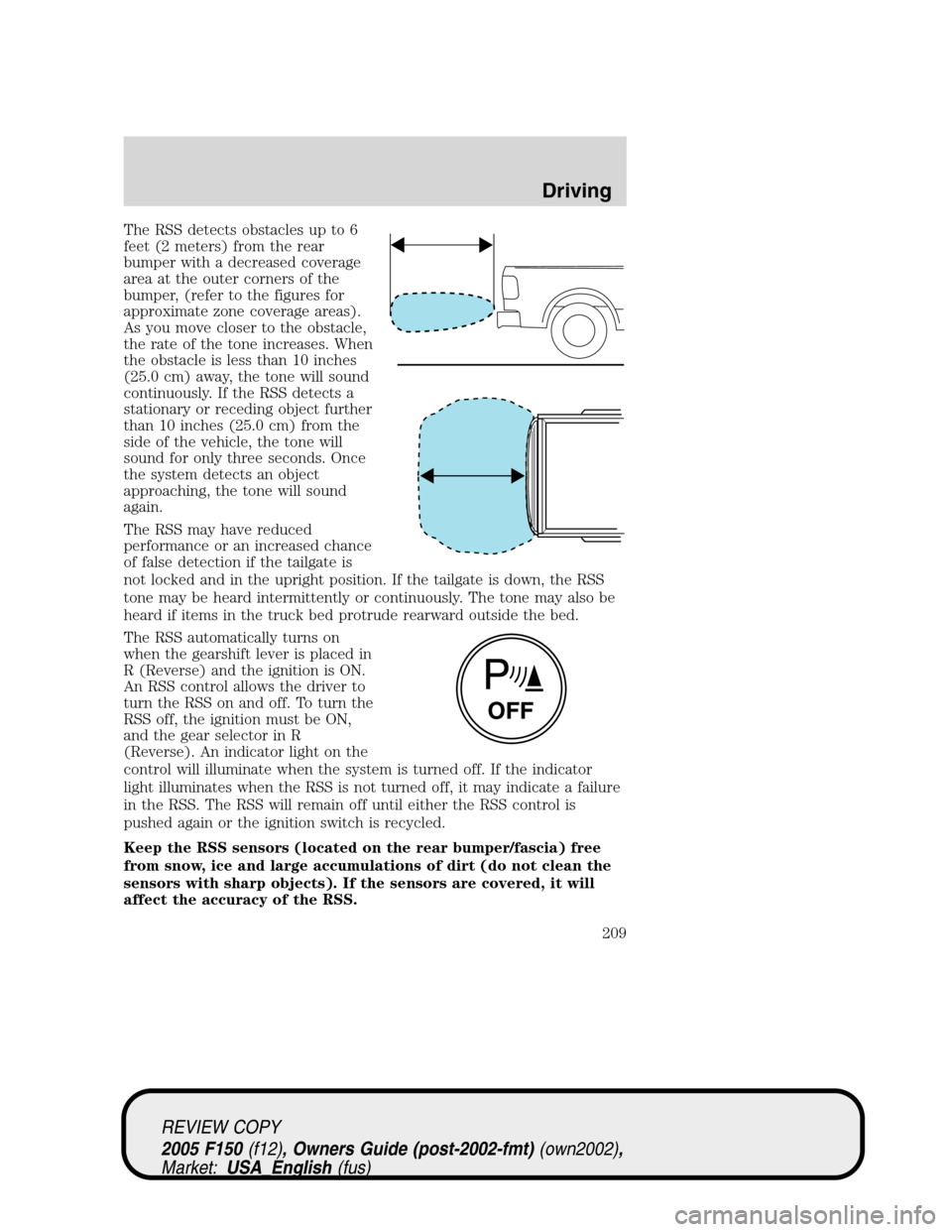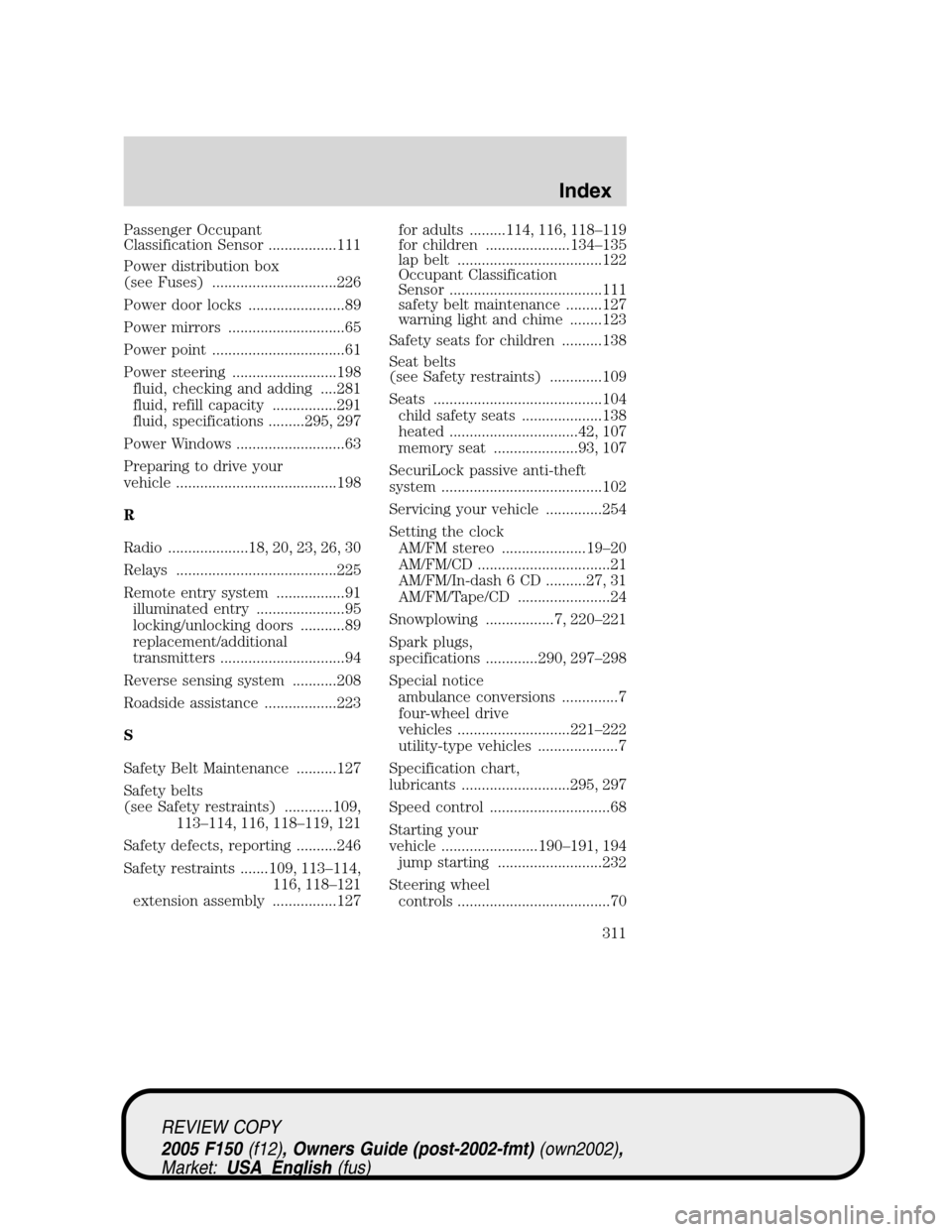sensor FORD F150 2005 11.G User Guide
[x] Cancel search | Manufacturer: FORD, Model Year: 2005, Model line: F150, Model: FORD F150 2005 11.GPages: 312, PDF Size: 4.15 MB
Page 129 of 312

crash severity are appropriate to activate these devices. Refer to the
Personal Safety Systemsection in this chapter.
The front passenger air bag is not designed to offer protection to
an occupant in the center front seating position.
Modifying or adding equipment to the front end of the vehicle
(including frame, bumper, front end body structure and tow
hooks) may affect the performance of the air bag system, increasing
the risk of injury. Do not modify the front end of the vehicle.
Additional equipment may affect the performance of the air bag
sensors increasing the risk of injury. Please refer to theBody
Builders Layout Bookfor instructions about the appropriate
installation of additional equipment.
Children and air bags
For additional important safety
information, read all information on
safety restraints in this guide.
Children must always be properly
restrained. Accident statistics
suggest that children are safer when
properly restrained in the rear seat
than in the front seat. Failure to
follow these instructions may
increase the risk of injury in a
collision.
Air bags can kill or injure a
child in a child seat.
NEVERplace a rear-facing child
seat in front of an active air bag. If
you must use a forward-facing
child seat in the front seat, move
the seat all the way back.
If two adults and a child occupy a Regular Cab, properly restrain the
child in the center front unless doing so would interfere with driving the
REVIEW COPY
2005 F150(f12), Owners Guide (post-2002-fmt)(own2002),
Market:USA_English(fus)
Seating and Safety Restraints
129
Page 131 of 312

Several air bag system components get hot after inflation. Do not
touch them after inflation.
If the air bag has deployed,the air bag will not function
again and must be replaced immediately.If the air bag is not
replaced, the unrepaired area will increase the risk of injury in a
collision.
Determining if the system is operational
The SRS uses readiness lights in the instrument cluster or a tone to
indicate the condition of the system. Refer to theAir bag readiness
section in theInstrument clusterchapter. Routine maintenance of the
air bag is not required.
A difficulty with the system is indicated by one or more of the following:
•The readiness lights will either
flash or stay lit.
•The readiness lights will not
illuminate immediately after
ignition is turned on.
•A series of five beeps will be heard. The tone pattern will repeat
periodically until the problem and/or light are repaired.
If any of these things happen, even intermittently, have the SRS serviced
at your dealership or by a qualified technician immediately. Unless
serviced, the system may not function properly in the event of a
collision.
Disposal of air bags and air bag equipped vehicles
(including pretensioners)
See your local dealership or qualified technician. Air bags MUST BE
disposed of by qualified personnel.
Front passenger sensing system
The front passenger sensing system will turn off the front passenger’s
frontal air bag under certain conditions. The driver’s frontal air bag is not
part of the front passenger sensing system. The front passenger sensing
system works with sensors that are part of the front passenger’s seat and
safety belt. The sensors are designed to detect the presence of a
properly-seated occupant and determine if the front passenger’s frontal
air bag should be enabled (may inflate) or not.
REVIEW COPY
2005 F150(f12), Owners Guide (post-2002-fmt)(own2002),
Market:USA_English(fus)
Seating and Safety Restraints
131
Page 209 of 312

The RSS detects obstacles up to 6
feet (2 meters) from the rear
bumper with a decreased coverage
area at the outer corners of the
bumper, (refer to the figures for
approximate zone coverage areas).
As you move closer to the obstacle,
the rate of the tone increases. When
the obstacle is less than 10 inches
(25.0 cm) away, the tone will sound
continuously. If the RSS detects a
stationary or receding object further
than 10 inches (25.0 cm) from the
side of the vehicle, the tone will
sound for only three seconds. Once
the system detects an object
approaching, the tone will sound
again.
The RSS may have reduced
performance or an increased chance
of false detection if the tailgate is
not locked and in the upright position. If the tailgate is down, the RSS
tone may be heard intermittently or continuously. The tone may also be
heard if items in the truck bed protrude rearward outside the bed.
The RSS automatically turns on
when the gearshift lever is placed in
R (Reverse) and the ignition is ON.
An RSS control allows the driver to
turn the RSS on and off. To turn the
RSS off, the ignition must be ON,
and the gear selector in R
(Reverse). An indicator light on the
control will illuminate when the system is turned off. If the indicator
light illuminates when the RSS is not turned off, it may indicate a failure
in the RSS. The RSS will remain off until either the RSS control is
pushed again or the ignition switch is recycled.
Keep the RSS sensors (located on the rear bumper/fascia) free
from snow, ice and large accumulations of dirt (do not clean the
sensors with sharp objects). If the sensors are covered, it will
affect the accuracy of the RSS.
REVIEW COPY
2005 F150(f12), Owners Guide (post-2002-fmt)(own2002),
Market:USA_English(fus)
Driving
209
Page 229 of 312

Fuse/Relay
LocationFuse Amp
RatingPassenger Compartment Fuse Panel
Description
25 10A* LH low beam headlamp
26 20A* Horn relay (PCB3), Horn power
27 5A* Passenger Air bag Deactivation (PAD)
warning lamp, Cluster air bag warning
lamp, Cluster RUN /START power
28 5A* SecuriLock transceiver (PATS)
29 15A* PCM 4x4 power
30 15A* PCM 4x4 power
31 20A* Radio power
32 15A* Vapor Management Valve (VMV), A/C
clutch relay, Canister vent, Heated
Exhaust Gas Oxygen (HEGO) sensors #11
and #21, CMCV, Mass Air Flow (MAF)
sensor, VCT, Heated Positive Crankcase
Ventilation (PCV) valve (4.2L engine), CID
sensor (4.2L engine)
33 15A* Shift solenoid, CMS #12 and #22
34 20A* Fuel injectors and PCM power, Intake
Manifold Runner Control (4.2L engine)
35 20A* Instrument cluster high beam indicator,
High beam headlamps
36 10A* Trailer tow right turn/stop lamps
37 20A* Rear power point
38 25A* Subwoofer power
39 20A* Instrument panel power point
40 20A* Low beam headlamps, DRL
41 20A* Cigar lighter, Diagnostic connector power
42 10A* Trailer tow left turn/stop lamps
101 30A** Starter solenoid
102 20A** Ignition switch feed
103 20A** ABS valves
104—Not used
REVIEW COPY
2005 F150(f12), Owners Guide (post-2002-fmt)(own2002),
Market:USA_English(fus)
Roadside Emergencies
229
Page 311 of 312

Passenger Occupant
Classification Sensor .................111
Power distribution box
(see Fuses) ...............................226
Power door locks ........................89
Power mirrors .............................65
Power point .................................61
Power steering ..........................198
fluid, checking and adding ....281
fluid, refill capacity ................291
fluid, specifications .........295, 297
Power Windows ...........................63
Preparing to drive your
vehicle ........................................198
R
Radio ....................18, 20, 23, 26, 30
Relays ........................................225
Remote entry system .................91
illuminated entry ......................95
locking/unlocking doors ...........89
replacement/additional
transmitters ...............................94
Reverse sensing system ...........208
Roadside assistance ..................223
S
Safety Belt Maintenance ..........127
Safety belts
(see Safety restraints) ............109,
113–114, 116, 118–119, 121
Safety defects, reporting ..........246
Safety restraints .......109, 113–114,
116, 118–121
extension assembly ................127for adults .........114, 116, 118–119
for children .....................134–135
lap belt ....................................122
Occupant Classification
Sensor ......................................111
safety belt maintenance .........127
warning light and chime ........123
Safety seats for children ..........138
Seat belts
(see Safety restraints) .............109
Seats ..........................................104
child safety seats ....................138
heated ................................42, 107
memory seat .....................93, 107
SecuriLock passive anti-theft
system ........................................102
Servicing your vehicle ..............254
Setting the clock
AM/FM stereo .....................19–20
AM/FM/CD .................................21
AM/FM/In-dash 6 CD ..........27, 31
AM/FM/Tape/CD .......................24
Snowplowing .................7, 220–221
Spark plugs,
specifications .............290, 297–298
Special notice
ambulance conversions ..............7
four-wheel drive
vehicles ............................221–222
utility-type vehicles ....................7
Specification chart,
lubricants ...........................295, 297
Speed control ..............................68
Starting your
vehicle ........................190–191, 194
jump starting ..........................232
Steering wheel
controls ......................................70
REVIEW COPY
2005 F150(f12), Owners Guide (post-2002-fmt)(own2002),
Market:USA_English(fus)
Index
311